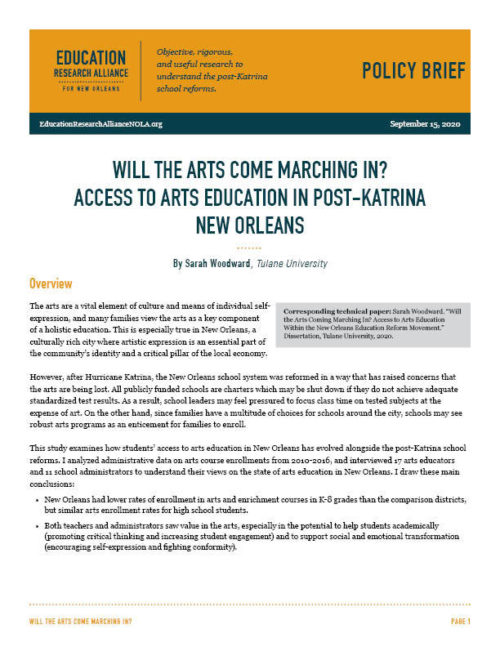Will the Arts Come Marching In? Access to Arts Education in Post-Katrina New Orleans
A study by Sarah Woodward explores how students’ access to arts education in New Orleans has evolved alongside the post-Katrina school reforms.

Will the Arts Come Marching In? Access to Arts Education in Post-Katrina New Orleans
Published
by Sarah Woodward
Many families view the arts as a key component of a holistic education. This is especially true in New Orleans, a culturally rich city where artistic expression is an essential part of the community’s identity and a critical pillar of the local economy. However, after Hurricane Katrina, the New Orleans school system was reformed in a way that has raised concerns that the arts are being lost. All publicly funded schools are charters which may be shut down if they do not achieve adequate standardized test results. As a result, school leaders may feel pressured to focus class time on tested subjects at the expense of art. On the other hand, since families have a multitude of choices for schools around the city, schools may see robust arts programs as an enticement for families to enroll. Drawing on arts course enrollment data from 2010 to 2016, as well as in-depth interviews with 28 art teachers and school administrators, the study offers an extensive overview of the arts education landscape in New Orleans, including visual art, dance, theater, music, and media art. The key findings are: — New Orleans had lower rates of enrollment in arts and enrichment courses in K‑8 grades than the comparison districts, but similar arts enrollment rates for high school students. — Both teachers and administrators saw value in the arts, especially in the potential to help students academically (promoting critical thinking and increasing student engagement) and to support social and emotional transformation (encouraging self-expression and fighting conformity). — School administrators valued arts education as a way to recruit students and families. Some arts educators felt that this was merely “marketing” or “PR” and that leaders emphasized breadth over depth in arts course offerings. — Art teachers felt that intense testing pressure and a decentralized school system were barriers to arts education. They often felt undermined in scheduling and administrative decisions, saw fewer opportunities for professional development, and felt isolated from the rest of the school and the wider arts education community. — School leadership played a key role in supporting the arts. Arts offerings varied greatly depending on the school leader’s personal values and belief in the importance of arts education. These results have important national implications. New Orleans is held up as a model for many urban school districts that are considering choice-based market reforms such as charter schools. By presenting the perspectives of New Orleans arts educators and school leaders, this study sheds light on both the challenges and the value of promoting arts education within a system of school choice and academic accountability. Moreover, these findings on the value of arts education gain new resonance in the context of the COVID-19 pandemic. At a time when students are experiencing radical upheaval in their lives, the arts offer a way to help children express themselves, process their emotions, and heal. Click [here](https://drive.google.com/file/d/1ShoCkeVUDVPlTe-qmUcyXXde-A51q_Ln/view?usp=sharing) to view the accompanying technical report.
Related Publications
Increasing Access to Head Start Through Text Messages
Jun 23, 2020 | by Alica Gerry, Lindsay Bell Weixler, Jon Valant, Daphna Bassok, Justin B. Doromal
Voices of New Orleans Youth: What Do the City's Young People Think About Their Schools and Communities?
Jun 8, 2020 | by Lindsay Bell Weixler, Douglas N. Harris, Alica Gerry
Do Charter Schools Keep Their Best Teachers and Improve Quality? Retention and Rewards for Teachers in New Orleans
Mar 9, 2020 | by Nathan Barrett, Deven Carlson, Douglas N. Harris, Jane Arnold Lincove

